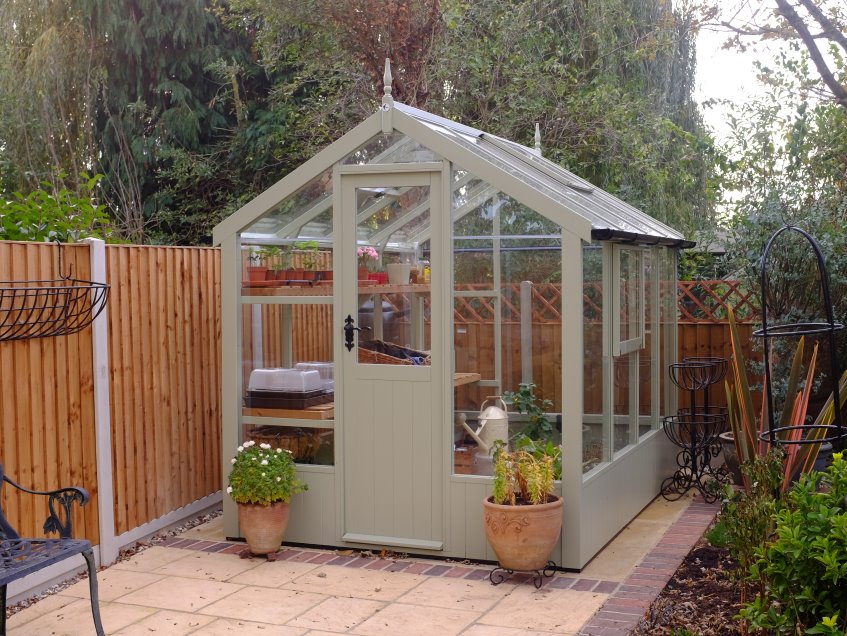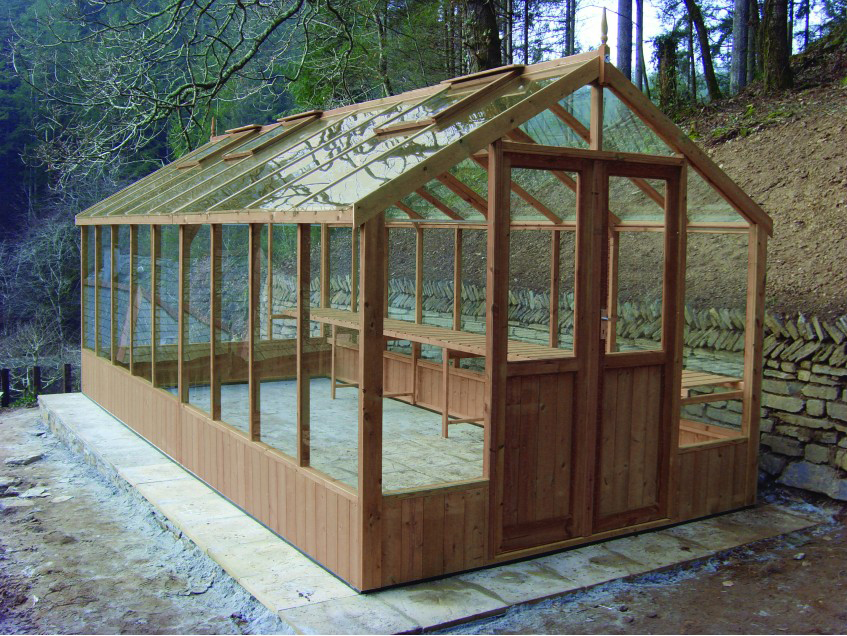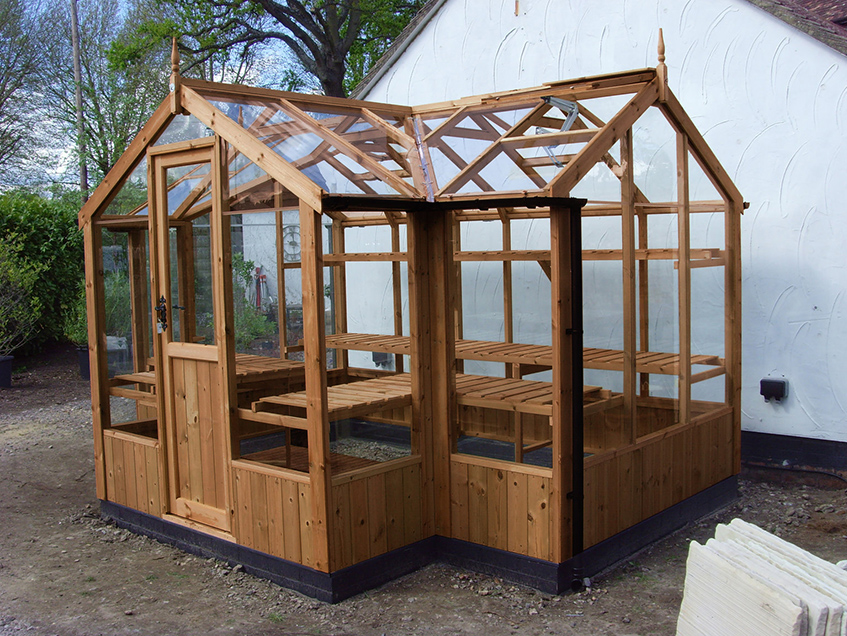FAQs
1. How do I choose a new greenhouse?
When choosing a greenhouse there are a number of considerations; the type of plants you want to grow, the amount of plants you require, the space available the visual appearance of the greenhouse and, of course your budget. Possible legal requirements may also be a factor in conservation and green belt areas.
At Swallow we believe we can accommodate most, if not all of the necessary requirements. For example, we offer a comprehensive range of sizes in the traditional apex, our most recent model the T-Shaped, which is a greenhouse with side porch.
2. What practical tips can I follow?
Survey your garden
It is important to consider the following factors whilst planning the best position for your new greenhouse;
1. Best Position and Aspect
It was traditionally recommended that a greenhouse should be positioned so that the ridge-line of the roof lies east to west to ensure that the longest side of the greenhouse will be fully exposed to the sun from the south. This is good advice, particularly for long greenhouses, but is not necessarily important for all greenhouses. As most common sizes of greenhouses, such as the 6'8 by 8'4 and 8'9 by 10'5, are virtually square an east to west orientation makes little practical difference. It is sufficient to position any one side of a small or medium sized greenhouse in a south or southwest facing aspect for best exposure to sunlight.
However, don't worry if this isn't possible because at between 7' and 8' tall, even if only the roof catches direct sunlight, this will be sufficient to warm-up your greenhouse considerably.
2. Foundations for the greenhouse base
A level, or almost level, site will require less work to achieve a good floor area for the foundations of your greenhouse. The most popular method of making a base is to lay flag stones ensuring the size is approximately 6 inches larger than the dimensions of the greenhouse.
- The ideal base as compacted sand and paving slab. This allows the floor to be swept, allows drainage and is ideal for pots, trays and grow bags.
- A traditional base is a stripped footing. This method is normally used for plants to grow out of the ground. This would consist of a small trench with concrete footing and then a course of bricks that typically would be one course out of the ground. The outer size would be identical to the size of the greenhouse.
3. Shelter from the wind
If your garden is in an exposed position then consider the proximity of hedges or fences that will provide some shelter from the direction of the prevailing wind. All greenhouses are vulnerable to strong winds so in the absence of shelter we would advise you to erect a fence or plant a hedge to provide at least some protection for your greenhouse.
4. Avoid Trees
To prevent potential damage to your greenhouse, overhanging trees are best avoided if at all possible.
5. Ease of use and maintenance
When deciding on the position for your greenhouse, also consider how convenient it will be to gain access round it. For example to clean the glass and to possibly apply periodic treatment.
6. Services
Consider how you will route water and perhaps an electricity supply to your chosen site. You will be surprised at how many useful greenhouse gadgets require electricity, for example, heaters, general lighting, growing lamps, propagators and automatic watering systems.
7. Visual appearance
All Swallow Timber greenhouses are pressure treated tantalised timber and add to the attractiveness of the existing garden. Greenhouses can be painted to complement an existing colour scheme.
At Swallow we believe we can accommodate most, if not all of the necessary requirements. For example, we offer a comprehensive range of sizes in the traditional apex and our most recent model the T-Shaped, which is a greenhouse with side porch.
3. I've decided on the best position for my greenhouse, now what do I do?
A greenhouse cannot be selected until the width and length of the site has been measured. It is important to leave sufficient space around the perimeter of the greenhouse base, for example 1 metre, to allow maintenance access. Also take into consideration the space required for a water butt, if required.
It is important to consider the following factors whilst planning the best position for your new greenhouse;
1. Best Position and Aspect
It was traditionally recommended that a greenhouse should be positioned so that the ridge-line of the roof lies east to west to ensure that the longest side of the greenhouse will be fully exposed to the sun from the south. This is good advice, particularly for long greenhouses, but is not necessarily important for all greenhouses. As most common sizes of greenhouses, such as the 6'8 by 8'4 and 8'9 by 10'5, are virtually square an east to west orientation makes little practical difference. It is sufficient to position any one side of a small or medium sized greenhouse in a south or southwest facing aspect for best exposure to sunlight.
However, don't worry if this isn't possible because at between 7' and 8' tall, even if only the roof catches direct sunlight, this will be sufficient to warm-up your greenhouse considerably.
2. Foundations for the greenhouse base
A level, or almost level, site will require less work to achieve a good floor area for the foundations of your greenhouse. The most popular method of making a base is to lay flag stones ensuring the size is approximately 6 inches larger than the dimensions of the greenhouse.
- The ideal base as compacted sand and paving slab. This allows the floor to be swept, allows drainage and is ideal for pots, trays and grow bags.
- A traditional base is a stripped footing. This method is normally used for plants to grow out of the ground. This would consist of a small trench with concrete footing and then a course of bricks that typically would be one course out of the ground. The outer size would be identical to the size of the greenhouse.
3. Shelter from the wind
If your garden is in an exposed position then consider the proximity of hedges or fences that will provide some shelter from the direction of the prevailing wind. All greenhouses are vulnerable to strong winds so in the absence of shelter we would advise you to erect a fence or plant a hedge to provide at least some protection for your greenhouse.
4. Avoid Trees
To prevent potential damage to your greenhouse, overhanging trees are best avoided if at all possible.
5. Ease of use and maintenance
When deciding on the position for your greenhouse, also consider how convenient it will be to gain access round it. For example to clean the glass and to possibly apply periodic treatment.
6. Services
Consider how you will route water and perhaps an electricity supply to your chosen site. You will be surprised at how many useful greenhouse gadgets require electricity, for example, heaters, general lighting, growing lamps, propagators and automatic watering systems.
7. Visual appearance
All Swallow Timber greenhouses are pressure treated tantalised timber and add to the attractiveness of the existing garden. Greenhouses can be painted to complement an existing colour scheme.
At Swallow we believe we can accommodate most, if not all of the necessary requirements. For example, we offer a comprehensive range of sizes in the traditional apex and our most recent model the T-Shaped, which is a greenhouse with side porch.
4. What are the most common Swallow greenhouse styles?
Swallow offer three greenhouse styles to cater for our customer requirements; Traditional Freestanding Apex, Lean-To and T-Shaped. Our most popular greenhouses are Traditional Apex style and are available in three gable widths; the Kingfisher (6’8), the Raven (8’9) and the Falcon (13’1). All of these greenhouses are available in a multitude of lengths so there should be an appropriate model to suit most sizes of garden.
The T-Shaped greenhouse is an impressive structure which is a garden feature as well as a valuable growing station. These models have two front returned stagings as standard, ideal for storing seedlings and a large internal growing area. The Cygnet greenhouse measures (6’8 x 11’5) with porch (6’8 x 2’5) as standard. This range is also available in other sizes.
It is important to consider the following factors whilst planning the best position for your new greenhouse;
1. Best Position and Aspect
It was traditionally recommended that a greenhouse should be positioned so that the ridge-line of the roof lies east to west to ensure that the longest side of the greenhouse will be fully exposed to the sun from the south. This is good advice, particularly for long greenhouses, but is not necessarily important for all greenhouses. As most common sizes of greenhouses, such as the 6'8 by 8'4 and 8'9 by 10'5, are virtually square an east to west orientation makes little practical difference. It is sufficient to position any one side of a small or medium sized greenhouse in a south or southwest facing aspect for best exposure to sunlight.
However, don't worry if this isn't possible because at between 7' and 8' tall, even if only the roof catches direct sunlight, this will be sufficient to warm-up your greenhouse considerably.
2. Foundations for the greenhouse base
A level, or almost level, site will require less work to achieve a good floor area for the foundations of your greenhouse. The most popular method of making a base is to lay flag stones ensuring the size is approximately 6 inches larger than the dimensions of the greenhouse.
- The ideal base as compacted sand and paving slab. This allows the floor to be swept, allows drainage and is ideal for pots, trays and grow bags.
- A traditional base is a stripped footing. This method is normally used for plants to grow out of the ground. This would consist of a small trench with concrete footing and then a course of bricks that typically would be one course out of the ground. The outer size would be identical to the size of the greenhouse.
3. Shelter from the wind
If your garden is in an exposed position then consider the proximity of hedges or fences that will provide some shelter from the direction of the prevailing wind. All greenhouses are vulnerable to strong winds so in the absence of shelter we would advise you to erect a fence or plant a hedge to provide at least some protection for your greenhouse.
4. Avoid Trees
To prevent potential damage to your greenhouse, overhanging trees are best avoided if at all possible.
5. Ease of use and maintenance
When deciding on the position for your greenhouse, also consider how convenient it will be to gain access round it. For example to clean the glass and to possibly apply periodic treatment.
6. Services
Consider how you will route water and perhaps an electricity supply to your chosen site. You will be surprised at how many useful greenhouse gadgets require electricity, for example, heaters, general lighting, growing lamps, propagators and automatic watering systems.
7. Visual appearance
All Swallow Timber greenhouses are pressure treated tantalised timber and add to the attractiveness of the existing garden. Greenhouses can be painted to complement an existing colour scheme.
At Swallow we believe we can accommodate most, if not all of the necessary requirements. For example, we offer a comprehensive range of sizes in the traditional apex, and our most recent model the T-Shaped, which is a greenhouse with side porch.
5. What size of greenhouse do I need?
This decision is based upon the size of the garden and budget of the customer. However the most common complaint is that the greenhouse is too small. We would therefore advise choosing the largest size based on the space available to maximise growing and storage room to its full potential.
The T-Shaped greenhouse is an impressive structure which is a garden feature as well as a valuable growing station. These models have two front returned stagings as standard, ideal for storing seedlings and a large internal growing area. The Cygnet greenhouse measures (6’8 x 11’5) with porch (6’8 x 2’5) as standard. This range is also available in other sizes.
It is important to consider the following factors whilst planning the best position for your new greenhouse;
1. Best Position and Aspect
It was traditionally recommended that a greenhouse should be positioned so that the ridge-line of the roof lies east to west to ensure that the longest side of the greenhouse will be fully exposed to the sun from the south. This is good advice, particularly for long greenhouses, but is not necessarily important for all greenhouses. As most common sizes of greenhouses, such as the 6'8 by 8'4 and 8'9 by 10'5, are virtually square an east to west orientation makes little practical difference. It is sufficient to position any one side of a small or medium sized greenhouse in a south or southwest facing aspect for best exposure to sunlight.
However, don't worry if this isn't possible because at between 7' and 8' tall, even if only the roof catches direct sunlight, this will be sufficient to warm-up your greenhouse considerably.
2. Foundations for the greenhouse base
A level, or almost level, site will require less work to achieve a good floor area for the foundations of your greenhouse. The most popular method of making a base is to lay flag stones ensuring the size is approximately 6 inches larger than the dimensions of the greenhouse.
- The ideal base as compacted sand and paving slab. This allows the floor to be swept, allows drainage and is ideal for pots, trays and grow bags.
- A traditional base is a stripped footing. This method is normally used for plants to grow out of the ground. This would consist of a small trench with concrete footing and then a course of bricks that typically would be one course out of the ground. The outer size would be identical to the size of the greenhouse.
3. Shelter from the wind
If your garden is in an exposed position then consider the proximity of hedges or fences that will provide some shelter from the direction of the prevailing wind. All greenhouses are vulnerable to strong winds so in the absence of shelter we would advise you to erect a fence or plant a hedge to provide at least some protection for your greenhouse.
4. Avoid Trees
To prevent potential damage to your greenhouse, overhanging trees are best avoided if at all possible.
5. Ease of use and maintenance
When deciding on the position for your greenhouse, also consider how convenient it will be to gain access round it. For example to clean the glass and to possibly apply periodic treatment.
6. Services
Consider how you will route water and perhaps an electricity supply to your chosen site. You will be surprised at how many useful greenhouse gadgets require electricity, for example, heaters, general lighting, growing lamps, propagators and automatic watering systems.
7. Visual appearance
All Swallow Timber greenhouses are pressure treated tantalised timber and add to the attractiveness of the existing garden. Greenhouses can be painted to complement an existing colour scheme.
At Swallow we believe we can accommodate most, if not all of the necessary requirements. For example, we offer a comprehensive range of sizes in the traditional apex and our most recent model the T-Shaped, which is a greenhouse with side porch.
6. How do I maximise growing capacity?
The average starter greenhouse is our top selling Kingfisher greenhouse which measures 6'8 wide by 8'4 long. Although this is classed as a small greenhouse, it provides enough room inside for full length staging down one side as standard whilst allowing additional extras such as high level shelving to be installed above. This is an ideal working bench with enough space to keep your potted plants. On the opposite side of the greenhouse there is still space for a row of grow bags for tomatoes or other tall plants and additional shelving. The effective use of a mix of shelving and staging can significantly increase the growing capacity of even a small greenhouse.
The T-Shaped greenhouse is an impressive structure which is a garden feature as well as a valuable growing station. These models have two front returned stagings as standard, ideal for storing seedlings and a large internal growing area. The Cygnet greenhouse measures (6’8 x 11’5) with porch (6’8 x 2’5) as standard. This range is also available in other sizes.
It is important to consider the following factors whilst planning the best position for your new greenhouse;
1. Best Position and Aspect
It was traditionally recommended that a greenhouse should be positioned so that the ridge-line of the roof lies east to west to ensure that the longest side of the greenhouse will be fully exposed to the sun from the south. This is good advice, particularly for long greenhouses, but is not necessarily important for all greenhouses. As most common sizes of greenhouses, such as the 6'8 by 8'4 and 8'9 by 10'5, are virtually square an east to west orientation makes little practical difference. It is sufficient to position any one side of a small or medium sized greenhouse in a south or southwest facing aspect for best exposure to sunlight.
However, don't worry if this isn't possible because at between 7' and 8' tall, even if only the roof catches direct sunlight, this will be sufficient to warm-up your greenhouse considerably.
2. Foundations for the greenhouse base
A level, or almost level, site will require less work to achieve a good floor area for the foundations of your greenhouse. The most popular method of making a base is to lay flag stones ensuring the size is approximately 6 inches larger than the dimensions of the greenhouse.
- The ideal base as compacted sand and paving slab. This allows the floor to be swept, allows drainage and is ideal for pots, trays and grow bags.
- A traditional base is a stripped footing. This method is normally used for plants to grow out of the ground. This would consist of a small trench with concrete footing and then a course of bricks that typically would be one course out of the ground. The outer size would be identical to the size of the greenhouse.
3. Shelter from the wind
If your garden is in an exposed position then consider the proximity of hedges or fences that will provide some shelter from the direction of the prevailing wind. All greenhouses are vulnerable to strong winds so in the absence of shelter we would advise you to erect a fence or plant a hedge to provide at least some protection for your greenhouse.
4. Avoid Trees
To prevent potential damage to your greenhouse, overhanging trees are best avoided if at all possible.
5. Ease of use and maintenance
When deciding on the position for your greenhouse, also consider how convenient it will be to gain access round it. For example to clean the glass and to possibly apply periodic treatment.
6. Services
Consider how you will route water and perhaps an electricity supply to your chosen site. You will be surprised at how many useful greenhouse gadgets require electricity, for example, heaters, general lighting, growing lamps, propagators and automatic watering systems.
7. Visual appearance
All Swallow Timber greenhouses are pressure treated tantalised timber and add to the attractiveness of the existing garden. Greenhouses can be painted to complement an existing colour scheme.
At Swallow we believe we can accommodate most, if not all of the necessary requirements. For example, we offer a comprehensive range of sizes in the traditional apex and our most recent model the T-Shaped, which is a greenhouse with side porch.
7. Which is the best foundation for drainage, concrete or paving slabs?
We would advise the use of paving slabs in preference to solid concrete for the base. Slabs provide natural drainage inside the greenhouse by allowing water to escape through the gaps between the slabs. This natural drainage of your greenhouse floor is an important benefit of using a foundation made with slabs. If you lay a solid concrete floor with a membrane and then paint or tile it, it will look very nice, but you'll find puddles of water forming on top of the floor which may cause a slip hazard.
It is a fact that no greenhouse is 100% waterproof! Water can come in under the bottom of the greenhouse, through the roof vents in severe driving rain, and over zealous watering and so it is very important to allow the water somewhere to escape naturally.
The T-Shaped greenhouse is an impressive structure which is a garden feature as well as a valuable growing station. These models have two front returned stagings as standard, ideal for storing seedlings and a large internal growing area. The Cygnet greenhouse measures (6’8 x 11’5) with porch (6’8 x 2’5) as standard. This range is also available in other sizes.
It is important to consider the following factors whilst planning the best position for your new greenhouse;
1. Best Position and Aspect
It was traditionally recommended that a greenhouse should be positioned so that the ridge-line of the roof lies east to west to ensure that the longest side of the greenhouse will be fully exposed to the sun from the south. This is good advice, particularly for long greenhouses, but is not necessarily important for all greenhouses. As most common sizes of greenhouses, such as the 6'8 by 8'4 and 8'9 by 10'5, are virtually square an east to west orientation makes little practical difference. It is sufficient to position any one side of a small or medium sized greenhouse in a south or southwest facing aspect for best exposure to sunlight.
However, don't worry if this isn't possible because at between 7' and 8' tall, even if only the roof catches direct sunlight, this will be sufficient to warm-up your greenhouse considerably.
2. Foundations for the greenhouse base
A level, or almost level, site will require less work to achieve a good floor area for the foundations of your greenhouse. The most popular method of making a base is to lay flag stones ensuring the size is approximately 6 inches larger than the dimensions of the greenhouse.
- The ideal base as compacted sand and paving slab. This allows the floor to be swept, allows drainage and is ideal for pots, trays and grow bags.
- A traditional base is a stripped footing. This method is normally used for plants to grow out of the ground. This would consist of a small trench with concrete footing and then a course of bricks that typically would be one course out of the ground. The outer size would be identical to the size of the greenhouse.
3. Shelter from the wind
If your garden is in an exposed position then consider the proximity of hedges or fences that will provide some shelter from the direction of the prevailing wind. All greenhouses are vulnerable to strong winds so in the absence of shelter we would advise you to erect a fence or plant a hedge to provide at least some protection for your greenhouse.
4. Avoid Trees
To prevent potential damage to your greenhouse, overhanging trees are best avoided if at all possible.
5. Ease of use and maintenance
When deciding on the position for your greenhouse, also consider how convenient it will be to gain access round it. For example to clean the glass and to possibly apply periodic treatment.
6. Services
Consider how you will route water and perhaps an electricity supply to your chosen site. You will be surprised at how many useful greenhouse gadgets require electricity, for example, heaters, general lighting, growing lamps, propagators and automatic watering systems.
7. Visual appearance
All Swallow Timber greenhouses are pressure treated tantalised timber and add to the attractiveness of the existing garden. Greenhouses can be painted to complement an existing colour scheme.
At Swallow we believe we can accommodate most, if not all of the necessary requirements. For example, we offer a comprehensive range of sizes in the traditional apex and our most recent model the T-Shaped, which is a greenhouse with side porch.
8. How accurate do the measurements of my foundations need to be?
We recommend that you make the area of slabs slightly bigger than the footprint of the greenhouse. For example, for a Kingfisher (6'8 x 8'4) greenhouse, you might slab an area 8'x10'. This could then allow you to position water butts on a firm foundation either side of your greenhouse. The measurement does not need to be accurate, it can be to the nearest slab.
If you decide to have a brick base this does need to be accurate and the outer measurement of the brickwork is the same as the outer greenhouse dimensions.
It is a fact that no greenhouse is 100% waterproof! Water can come in under the bottom of the greenhouse, through the roof vents in severe driving rain, and over zealous watering and so it is very important to allow the water somewhere to escape naturally.
The T-Shaped greenhouse is an impressive structure which is a garden feature as well as a valuable growing station. These models have two front returned stagings as standard, ideal for storing seedlings and a large internal growing area. The Cygnet greenhouse measures (6’8 x 11’5) with porch (6’8 x 2’5) as standard. This range is also available in other sizes.
It is important to consider the following factors whilst planning the best position for your new greenhouse;
1. Best Position and Aspect
It was traditionally recommended that a greenhouse should be positioned so that the ridge-line of the roof lies east to west to ensure that the longest side of the greenhouse will be fully exposed to the sun from the south. This is good advice, particularly for long greenhouses, but is not necessarily important for all greenhouses. As most common sizes of greenhouses, such as the 6'8 by 8'4 and 8'9 by 10'5, are virtually square an east to west orientation makes little practical difference. It is sufficient to position any one side of a small or medium sized greenhouse in a south or southwest facing aspect for best exposure to sunlight.
However, don't worry if this isn't possible because at between 7' and 8' tall, even if only the roof catches direct sunlight, this will be sufficient to warm-up your greenhouse considerably.
2. Foundations for the greenhouse base
A level, or almost level, site will require less work to achieve a good floor area for the foundations of your greenhouse. The most popular method of making a base is to lay flag stones ensuring the size is approximately 6 inches larger than the dimensions of the greenhouse.
- The ideal base as compacted sand and paving slab. This allows the floor to be swept, allows drainage and is ideal for pots, trays and grow bags.
- A traditional base is a stripped footing. This method is normally used for plants to grow out of the ground. This would consist of a small trench with concrete footing and then a course of bricks that typically would be one course out of the ground. The outer size would be identical to the size of the greenhouse.
3. Shelter from the wind
If your garden is in an exposed position then consider the proximity of hedges or fences that will provide some shelter from the direction of the prevailing wind. All greenhouses are vulnerable to strong winds so in the absence of shelter we would advise you to erect a fence or plant a hedge to provide at least some protection for your greenhouse.
4. Avoid Trees
To prevent potential damage to your greenhouse, overhanging trees are best avoided if at all possible.
5. Ease of use and maintenance
When deciding on the position for your greenhouse, also consider how convenient it will be to gain access round it. For example to clean the glass and to possibly apply periodic treatment.
6. Services
Consider how you will route water and perhaps an electricity supply to your chosen site. You will be surprised at how many useful greenhouse gadgets require electricity, for example, heaters, general lighting, growing lamps, propagators and automatic watering systems.
7. Visual appearance
All Swallow Timber greenhouses are pressure treated tantalised timber and add to the attractiveness of the existing garden. Greenhouses can be painted to complement an existing colour scheme.
At Swallow we believe we can accommodate most, if not all of the necessary requirements. For example, we offer a comprehensive range of sizes in the traditional apex and our most recent model the T-Shaped, which is a greenhouse with side porch.
9.What is toughened safety glass?
In brief, the glass is heated and then allowed to cool in a controlled environment. This alters the molecular structure of the glass which reduces tension and improves the strength by approximately three times that of standard glass.
All Swallow greenhouses are equipped with toughened safety glass as standard. This special type of glass is unique, as in the unlikely event of the glass breaking it will not shatter and leave dangerous shards exposed. Instead the glass will shatter into diamond sized pieces, much the same as a car window in an accident. This is a far safer form of glazing, especially in stormy weather or in an environment where there are children present.
At Swallow we then stack the timber with small lathes of timber between to allow air drying. This process takes between four and six weeks, depending on the time of year.
No further treatment is required but the greenhouse would benefit a quick coat of spirit based preservative annually. If you would like a coloured finish you can paint over pressure treated timber with normal wood preservative in any colour.
If you decide to have a brick base this does need to be accurate and the outer measurement of the brickwork is the same as the outer greenhouse dimensions.
It is a fact that no greenhouse is 100% waterproof! Water can come in under the bottom of the greenhouse, through the roof vents in severe driving rain, and over zealous watering and so it is very important to allow the water somewhere to escape naturally.
The T-Shaped greenhouse is an impressive structure which is a garden feature as well as a valuable growing station. These models have two front returned stagings as standard, ideal for storing seedlings and a large internal growing area. The Cygnet greenhouse measures (6’8 x 11’5) with porch (6’8 x 2’5) as standard. This range is also available in other sizes.
It is important to consider the following factors whilst planning the best position for your new greenhouse;
1. Best Position and Aspect
It was traditionally recommended that a greenhouse should be positioned so that the ridge-line of the roof lies east to west to ensure that the longest side of the greenhouse will be fully exposed to the sun from the south. This is good advice, particularly for long greenhouses, but is not necessarily important for all greenhouses. As most common sizes of greenhouses, such as the 6'8 by 8'4 and 8'9 by 10'5, are virtually square an east to west orientation makes little practical difference. It is sufficient to position any one side of a small or medium sized greenhouse in a south or southwest facing aspect for best exposure to sunlight.
However, don't worry if this isn't possible because at between 7' and 8' tall, even if only the roof catches direct sunlight, this will be sufficient to warm-up your greenhouse considerably.
2. Foundations for the greenhouse base
A level, or almost level, site will require less work to achieve a good floor area for the foundations of your greenhouse. The most popular method of making a base is to lay flag stones ensuring the size is approximately 6 inches larger than the dimensions of the greenhouse.
- The ideal base as compacted sand and paving slab. This allows the floor to be swept, allows drainage and is ideal for pots, trays and grow bags.
- A traditional base is a stripped footing. This method is normally used for plants to grow out of the ground. This would consist of a small trench with concrete footing and then a course of bricks that typically would be one course out of the ground. The outer size would be identical to the size of the greenhouse.
3. Shelter from the wind
If your garden is in an exposed position then consider the proximity of hedges or fences that will provide some shelter from the direction of the prevailing wind. All greenhouses are vulnerable to strong winds so in the absence of shelter we would advise you to erect a fence or plant a hedge to provide at least some protection for your greenhouse.
4. Avoid Trees
To prevent potential damage to your greenhouse, overhanging trees are best avoided if at all possible.
5. Ease of use and maintenance
When deciding on the position for your greenhouse, also consider how convenient it will be to gain access round it. For example to clean the glass and to possibly apply periodic treatment.
6. Services
Consider how you will route water and perhaps an electricity supply to your chosen site. You will be surprised at how many useful greenhouse gadgets require electricity, for example, heaters, general lighting, growing lamps, propagators and automatic watering systems.
7. Visual appearance
All Swallow Timber greenhouses are pressure treated tantalised timber and add to the attractiveness of the existing garden. Greenhouses can be painted to complement an existing colour scheme.
At Swallow we believe we can accommodate most, if not all of the necessary requirements. For example, we offer a comprehensive range of sizes in the traditional apex and our most recent model the T-Shaped, which is a greenhouse with side porch.
9.What is toughened safety glass?
In brief, the glass is heated and then allowed to cool in a controlled environment. This alters the molecular structure of the glass which reduces tension and improves the strength by approximately three times that of standard glass.
All Swallow greenhouses are equipped with toughened safety glass as standard. This special type of glass is unique, as in the unlikely event of the glass breaking it will not shatter and leave dangerous shards exposed. Instead the glass will shatter into diamond sized pieces, much the same as a car window in an accident. This is a far safer form of glazing, especially in stormy weather or in an environment where there are children present.
At Swallow we then stack the timber with small lathes of timber between to allow air drying. This process takes between four and six weeks, depending on the time of year.
No further treatment is required but the greenhouse would benefit a quick coat of spirit based preservative annually. If you would like a coloured finish you can paint over pressure treated timber with normal wood preservative in any colour.
If you decide to have a brick base this does need to be accurate and the outer measurement of the brickwork is the same as the outer greenhouse dimensions.
It is a fact that no greenhouse is 100% waterproof! Water can come in under the bottom of the greenhouse, through the roof vents in severe driving rain, and over zealous watering and so it is very important to allow the water somewhere to escape naturally.
Lean-To greenhouses are fixed to an existing wall and were traditionally used for growing vines. Ideally they should be fixed to a south facing wall. The main benefit of this type of greenhouse is that the wall acts like a storage heater by slowly releasing the stored warmth from the sun throughout the evening, ensuring plants have an effective growing environment. Swallow (GB) have three gable widths available; the Finch (4’6), the Dove (6’8) and the Heron (8’9). All of these models are available in a multitude of lengths to suit the customer.
The T-Shaped greenhouse is an impressive structure which is a garden feature as well as a valuable growing station. These models have two front returned stagings as standard, ideal for storing seedlings and a large internal growing area. The Cygnet greenhouse measures (6’8 x 11’5) with porch (6’8 x 2’5) as standard. This range is also available in other sizes.
It is important to consider the following factors whilst planning the best position for your new greenhouse;
1. Best Position and Aspect
It was traditionally recommended that a greenhouse should be positioned so that the ridge-line of the roof lies east to west to ensure that the longest side of the greenhouse will be fully exposed to the sun from the south. This is good advice, particularly for long greenhouses, but is not necessarily important for all greenhouses. As most common sizes of greenhouses, such as the 6'8 by 8'4 and 8'9 by 10'5, are virtually square an east to west orientation makes little practical difference. It is sufficient to position any one side of a small or medium sized greenhouse in a south or southwest facing aspect for best exposure to sunlight.
However, don't worry if this isn't possible because at between 7' and 8' tall, even if only the roof catches direct sunlight, this will be sufficient to warm-up your greenhouse considerably.
2. Foundations for the greenhouse base
A level, or almost level, site will require less work to achieve a good floor area for the foundations of your greenhouse. The most popular method of making a base is to lay flag stones ensuring the size is approximately 6 inches larger than the dimensions of the greenhouse.
- The ideal base as compacted sand and paving slab. This allows the floor to be swept, allows drainage and is ideal for pots, trays and grow bags.
- A traditional base is a stripped footing. This method is normally used for plants to grow out of the ground. This would consist of a small trench with concrete footing and then a course of bricks that typically would be one course out of the ground. The outer size would be identical to the size of the greenhouse.
3. Shelter from the wind
If your garden is in an exposed position then consider the proximity of hedges or fences that will provide some shelter from the direction of the prevailing wind. All greenhouses are vulnerable to strong winds so in the absence of shelter we would advise you to erect a fence or plant a hedge to provide at least some protection for your greenhouse.
4. Avoid Trees
To prevent potential damage to your greenhouse, overhanging trees are best avoided if at all possible.
5. Ease of use and maintenance
When deciding on the position for your greenhouse, also consider how convenient it will be to gain access round it. For example to clean the glass and to possibly apply periodic treatment.
6. Services
Consider how you will route water and perhaps an electricity supply to your chosen site. You will be surprised at how many useful greenhouse gadgets require electricity, for example, heaters, general lighting, growing lamps, propagators and automatic watering systems.
7. Visual appearance
All Swallow Timber greenhouses are pressure treated tantalised timber and add to the attractiveness of the existing garden. Greenhouses can be painted to complement an existing colour scheme.
At Swallow we believe we can accommodate most, if not all of the necessary requirements. For example, we offer a comprehensive range of sizes in the traditional apex, our Lean-To range and our most recent model the T-Shaped, which is a greenhouse with side porch.






